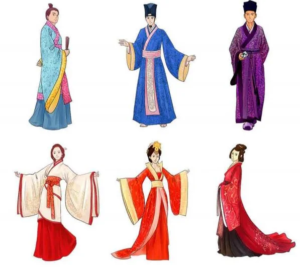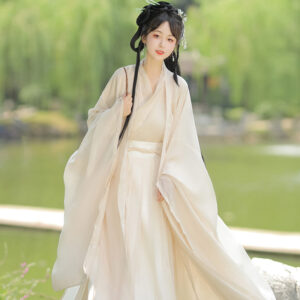
Hanfu, the traditional clothing of the Han Chinese, has undergone numerous transformations throughout China’s long history, with each dynasty contributing its unique influences on style, color, fabric, and design. While Hanfu maintained its fundamental structure—typically consisting of a robe or tunic paired with a skirt or pants—distinct variations emerged as the aesthetics of the time, cultural values, and external influences shaped the fashion.
Here’s a closer look at how Hanfu styles evolved during different Chinese dynasties:
1. Han Dynasty (206 BCE – 220 CE): The Foundations of Hanfu
The Han Dynasty marked the formalization of the Hanfu style. During this period, the clothing was simple, reflecting the Confucian values of modesty and humility. The Shenyi (深衣), a long robe that combined a top and a bottom into one piece, became a popular style, symbolizing unity and harmony.
- Structure and Features: The Shenyi had wide, loose sleeves, with the front of the robe overlapping on the right. It was worn by both men and women. Another common style was the Ruqun (襦裙), consisting of a blouse (Ru) and a long skirt (Qun).
- Colors: The Han Dynasty emphasized simplicity and functionality, and clothing colors were often muted, with shades of black, white, and light colors being dominant.
- Fabrics: Hemp and linen were common fabrics for daily wear, while silk was reserved for the upper classes.
2. Wei, Jin, and Northern and Southern Dynasties (220–589 CE): Fluid and Free
During the Wei, Jin, and Northern and Southern dynasties, Hanfu took on a more relaxed and free-flowing appearance. Influenced by Daoism, clothing became more fluid and unstructured, representing a rejection of rigid societal norms. The aesthetic was one of ethereal beauty, emphasizing ease and elegance.
- Styles: Loose-fitting robes with wide sleeves became common. The Ruqun remained popular, but the skirt was worn higher up on the waist, giving a more graceful and floating appearance.
- Influence of Foreign Cultures: This era saw significant cultural exchanges with Central Asian kingdoms, influencing Hanfu with exotic elements such as intricate embroidery and new fabric techniques.
3. Tang Dynasty (618–907 CE): Opulent and Cosmopolitan
The Tang Dynasty is often regarded as one of the most prosperous and culturally vibrant periods in Chinese history, and Hanfu styles reflected the wealth and cosmopolitan nature of the time. The Tang Dynasty’s open attitude toward foreign cultures, particularly from Central Asia, had a significant impact on clothing.
- Styles for Women: Women’s clothing became more daring and form-fitting. The Qixiong Ruqun (齐胸襦裙), a high-waisted skirt worn just below the chest, became a fashionable choice. Daxiushan (大袖衫), large-sleeved outer garments, added drama and grandeur to formal attire. Short tops paired with long flowing skirts became common, and women often wore transparent outer garments over these pieces.
- Styles for Men: Men typically wore wide-sleeved robes with round-collared shirts, influenced by Central Asian styles. Robes were often wrapped with a belt or sash, and high officials would wear more elaborate robes with intricate patterns.
- Colors and Fabrics: Rich, vibrant colors such as reds, purples, and golds were popular, and silk was the fabric of choice for the upper classes. Embroidery became more elaborate, featuring patterns of flowers, birds, and mythical creatures.
4. Song Dynasty (960–1279 CE): Elegant and Reserved
The Song Dynasty saw a return to a more conservative, modest style of Hanfu, influenced by the rise of Neo-Confucianism. The clothing emphasized restraint, practicality, and elegance, reflecting the intellectual and artistic achievements of the era.
- Styles: The Ruqun remained a staple for women, but the waistline was lowered again compared to the Tang Dynasty, and the skirts became narrower. For men, the Zhiduo (直裰), a long robe with straight edges, became popular. Scholars often wore simpler clothing that reflected their intellectual status, often in plain white or muted tones.
- Simplicity: Compared to the Tang Dynasty, the Song era focused more on simplicity and practicality. The excessive use of silk and embroidery was reserved for the elite, and clothing for the general population was more modest.
- Colors: Lighter and more neutral colors, like white, beige, and light blue, became prevalent. However, higher-ranking individuals still wore brighter colors for formal events.
5. Yuan Dynasty (1271–1368 CE): Mongol Influences
The Yuan Dynasty, founded by the Mongols, introduced distinct foreign influences to Hanfu, particularly in terms of cut, structure, and design. While traditional Hanfu styles persisted, new elements were introduced, particularly in formal and military clothing.
- Styles: Hanfu during the Yuan Dynasty was marked by the introduction of round-neck robes, a style that reflected Mongol preferences for practical, fitted clothing. The Mongolian Bianhu (便服, fitted jackets) became a popular addition to the traditional Hanfu, particularly among men.
- Military Influence: The Yuan Dynasty was a period of military expansion, and this was reflected in the clothing of the time. Men’s Hanfu became more fitted and practical, with shorter sleeves and narrower cuts to facilitate movement.
- Materials and Patterns: Silk and fur were commonly used for both everyday and formal attire. The use of dragon and phoenix motifs became more prominent, symbolizing imperial power and authority.
6. Ming Dynasty (1368–1644 CE): A Return to Tradition
The Ming Dynasty marked a conscious return to traditional Han Chinese culture and aesthetics after the foreign rule of the Yuan Dynasty. The Ming emperors encouraged the revival of traditional Hanfu styles, bringing back more conservative and structured clothing. The emphasis was on restoring Han cultural identity.
- Styles: The Shenyi returned as a prominent style, with long, wide sleeves and layers of clothing. Aoqun (袄裙), a jacket and skirt combination, became popular among women. For men, the Changshan (长衫) and Yisan (曳撒), a one-piece robe with flowing sleeves, were widely worn.
- Restoration of Symbols: Ming Dynasty Hanfu incorporated traditional symbols, such as the Twelve Ornaments (十二章), a set of symbols representing imperial power, which were embroidered onto robes.
- Colors and Patterns: Bright colors like red and yellow, as well as intricate embroidery, were used for formal occasions. The Mandarin square, a large embroidered badge sewn onto official robes, became a status symbol, with different patterns signifying rank.
7. Qing Dynasty (1644–1912 CE): The Decline of Hanfu
The Qing Dynasty, established by the Manchus, imposed significant changes to traditional Hanfu styles. The ruling Manchu elite introduced their own clothing style, known as Qizhuang (旗装), which eventually overshadowed Hanfu in official and everyday settings. However, Hanfu still survived in some regions and among the Han Chinese populace.
- Qizhuang Influence: The Changpao (长袍), a long one-piece robe with a standing collar, replaced traditional Hanfu styles. Manchu officials and nobility wore this style, which was more fitted and straight compared to Hanfu.
- Retaining Hanfu Elements: Despite Manchu influence, Hanfu continued to be worn for specific cultural and ceremonial occasions. Some Han scholars and commoners continued to wear traditional Shenyi and Ruqun.
- Colors and Embellishments: Imperial garments in the Qing Dynasty were heavily adorned with dragon motifs and gold thread embroidery, signifying the ruler’s power.
Conclusion: Hanfu’s Transformation Across Dynasties
Throughout Chinese history, Hanfu evolved in response to changes in social norms, cultural exchange, and dynastic shifts. Each dynasty left its mark on the styles, colors, and fabrics of Hanfu, from the opulence of the Tang to the modesty of the Song, and the Mongol-influenced practical styles of the Yuan to the return of tradition in the Ming. Even though the Qing Dynasty saw a decline in traditional Hanfu styles, the influence of Hanfu endures in modern times, inspiring fashion and cultural pride among the Han Chinese people.
Share this post
Recent Posts


What were the key features of Hanfu during the Tang Dynasty?

How did Hanfu styles vary during different Chinese dynasties?

What accessories are typically worn with Hanfu?

How do you choose the right Hanfu for different seasons?

Newsletter
Popular Categories
Related Post
Sed aliquam, tortor et sodales malesuada, lorem leo luctus tellus, quis interdum eros nibh in nunc. Cras dignissim malesuada, lorem leo luctus

What are the winter hanfu called?

What were the key features of Hanfu during the Tang Dynasty?

How did Hanfu styles vary during different Chinese dynasties?


